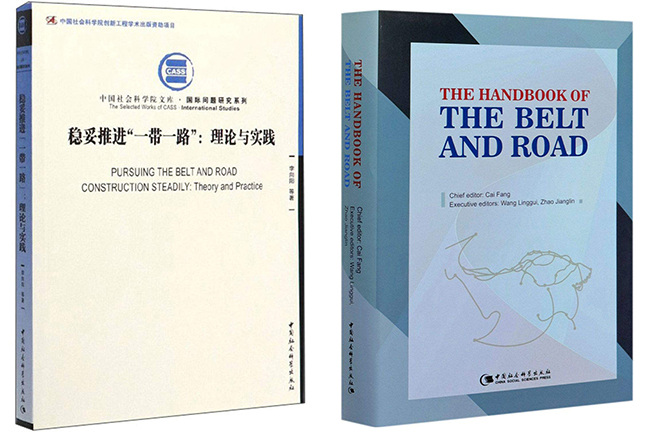BRI studies embrace rich outcomes

FILE PHOTOS: Research outcomes concerning the BRI
The report to the 20th CPC National Congress emphasized promoting the high-quality development of the Belt and Road Initiative (BRI). This year marks the ninth anniversary of the initiative. Over the past nine years, Chinese academia has actively followed its progress and carried out BRI research from different perspectives, yielding achievements that have contributed academic support for the further advancement of BRI construction.
Fruitful achievements
In the nine years since the initial proposal, Chinese academics have conducted research and investigations in more than 100 countries along the route, covering specific countries and regions, bilateral and multilateral cooperation, as well as policy communication, facility connectivity, unimpeded trade, financial integration, and people-to-people bonds. At the same time, various BRI research institutes have been established at all levels, generating academically rigorous viewpoints and discourse.
Using keywords like “BRI,” “21st Century Maritime Silk Road,” and “Silk Road Economic Belt” to search on academic resource discovery platforms, Liu Ying, director of the cooperation and research department of the Chongyang Institute for Financial Studies at Renmin University of China, retrieved a total of 150,000 related journal articles from between 2013 and 2021. Among them, the publication peak for BRI-related articles occurred between 2017 and 2019. In particular, during the first Belt and Road Forum for International Cooperation (BRF) in 2017, over 31,000 articles were published, the largest number ever.
According to Zhang Yaojun, a professor from the China Academy of Belt and Road Initiative at Beijing International Studies University, BRI research in Chinese academia focused mostly on language, culture, history and religion along the ancient Silk Road, as well as interpretations of the meaning of the “Belt and Road” and its geographical coverage during 2013–2014. From 2015 to 2016, scholars gradually deepened their understanding of the BRI’s contemporary significance, and extended their research to the political systems, legal systems, business environments, and foreign policy of participating countries.
“The BRI was increasingly recognized as an international initiative that integrates economic and trade cooperation and development, politics, diplomacy and security, as well as cultural exchanges and people-to-people bonds,” Zhang said.
Between 2017 and 2019, as China successfully held the first and second BRF, major issues related to the peaceful development of humanity became popular research subjects. Topics such as “building global value chains,” “providing international public goods,” “building a new type of international relations,” and “building a human community with a shared future” received particular attention. In 2020, the focus of BRI research shifted to a certain extent, as “global health governance,” “clean energy,” “green finance,” “tripartite cooperation,” and “the tendency of globalization” became latest research topics concerning the initiative, Zhang concluded.
Meanwhile, Chinese academics have published numerous academic papers and monographs concerning the BRI. Among them, scholars from the Chinese Academy of Social Sciences (CASS) have conducted thorough explorations in theory and practice. For example, two editions of The Handbook of the Belt and Road under the chief editorship of Cai Fang, former CASS vice president and chairman of the Silk Road Research Institute under CASS, have been published, with an English edition printed overseas as a result of the partnership with the British publisher Routledge. In addition, CASS Innovation Project achievements, such as Pursuing the Belt and Road Construction Steadily: Theoryand Practice, and The Economic Analysis of the Belt and Road, have been successively launched.
Improving research quality
Despite sound progress in BRI research, some problems loom large and breakthroughs have yet to be made. Theoretical supply does not match the actual demand, and there still exists much room for improving research productivity and academic innovation. For example, studies on related countries and regions are imbalanced, tilting more toward large or medium-sized countries, and less toward countries in Africa and Central and Eastern Europe.
In terms of the research field, BRI research remains scattered among many disciplines; its own professional attributes remain unclear; and connection and integration among different research fields are imperative. With respect to theoretical originality, Chinese academia tends to draw upon Western concepts or research paradigms, with fewer high-quality original achievements. In addition, more research has been done on applied countermeasures to hot issues, and less on basic theory.
In this regard, Zhang suggested accelerating cross-disciplinary integration, addressing the relationship between the globalization of knowledge and the localization of experience, and elevating region- and country-specific studies to become a systematic knowledge of universal significance.
As for specific topics, Zhang proposed deeply exploring the theoretical connotations of the BRI in promoting poverty reduction, urbanization, and industrialization in countries along the route. Also it is advisable to increase funding for research on major projects, financial support, investment environment, risk management and control, security, climate change, and other practical issues.
Edited by CHEN MIRONG
